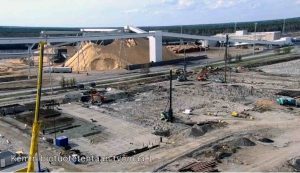Slow-TV seems to be hot for the moment. Maybe people in quarantine wants to kill time during the ongoing pandemic? Recently we wrote about the big moose-hiking, a number of webcams in the Swedish forest showing the wandering moose passing by. Now, the Finnish forest owner’s association Metsä offers slow-TV action during the erection of their new pulp mill in Kemi, live through three webcams.
Slow TV the Finnish way
We are talking about the building of the largest pulp mill in northern Europe. A mill that, when it´s up and running, will swallow almost 8 million cubic meters of pulp wood annually. I don´t know if they will get a vast number of viewers, but for the most interested nerds it should be worth watching.
Kemi is (kind of) an island at the estuary of the river Kemi, close to the town of Kemi. Here, pulp has been produced for 102 years. Two years from now, the new mill will be ready to take in use. A billion-dollar investment. But on the other hand, the production will then increase by 140 % to 1,5 million tons pulp per year. The Kemi mill will also produce other kinds of bioproducts and 2 TWh electricity, which is 2,5 % of the total production in Finland.
Photo: Google Maps
Increased need for raw material
140 % more pulp means 140 % more pulpwood. This will be achieved by developing the use of wood from peatland. This requires special expertise and knowledge to avoid leakage of greenhouse gases from the peatland. The importance of continuous forest management will increase to achieve this. If Metsä succeeds in creating methods for continuous forest management in peatlands, that could also be a subject for export.
Approximately 1 million cubic meter of pulpwood will be imported from the closest neighbor Sweden. How that will affect the Swedish pulpwood prices is difficult to predict. Generally, the Finnish wood prices have been higher than the Swedish so, hopefully for the Swedish forest owners, it will mean higher prices.
103.000 forest owners need 20 million cubic meters
Metsä is a forest owners’ association that is owned by 103.000 Finnish forest owners. During the last few years, they have invested heavily in pulp mills and today they own four pulp mills that will – when Kemi is up and running in 2023 – require over 20 million cubic meters raw material (pulpwood and woodchips) per year.
Photo: Metsä Fibre
Finnish “sisu” and change of vocabulary
In Finland they have “sisu”. That would be described as “go” in English. When they set up a goal, they reach it, by any means and in a large scale. Small scale trials are not interesting for the Finns. The above-mentioned investments are good examples of that.
Thanks to the Paris agreement, the EU Taxonomy and other forestry investigations, the forestry segment is seen in another way compared to earlier. No one seems to mind tree felling if the end-product ends up as wood in buildings or other long-lasting constructions. As sawn timber, lumber, the carbon dioxide stays in the wood. In the meantime, you plant new forest that also catches and stores carbon so that you actually get a double effect in storing carbon. Who can argue against that?
But paper products, especially hygiene paper, are short rotation products that releases the carbon quite soon after the tree has been cut in the forest. Some can be recycled a few times, such as “newspaper paper”. But tissues, toilet paper and diapers are often burned and the carbon is released.
From an environmental point of view, this is a problem for the paper industry. They also want to be environmentally friendly and good for the climate. If nothing else to please the market. Some paper companies claim they will decrease their use of virgin wood from boreal forests.
Metsä will develop new, environmentally friendly methods to grow forest on peatland to feed their new mill. Considering the ongoing debate about climate change, its effects and how to cope with it, no one can say that the Finns, or Metso, are cowards. That´s sisu! The sisu is strong and doesn´t only mean that Finland wins the ice hockey World Cup every now and then. They will probably also convince politicians and the public that they are doing the right thing.
When reading the press materials from Metsä, it´s worth noting that no pulp mills are mentioned. “Bioproduct mill” is the word. Why not? They do not only produce pulp but also pine oil and green electricity.
Photo: Metsä Fibre
This is a summary of an article at the sister site iSkogen.se signed Fredrik Reuter














